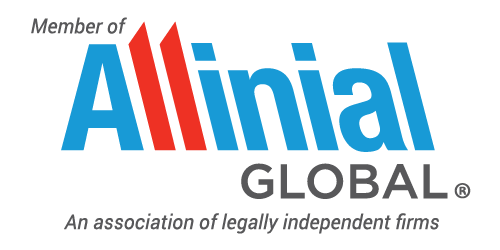Tax Withholding for Seasonal and Part-Time Employees
Many businesses hire part-time or full-time workers, especially in the summer. The IRS classifies these employees as seasonal workers, defined as employees performing labor or services on a seasonal basis (i.e., six months or less). Examples of this kind of work include retail workers employed exclusively during holiday seasons, sports events, or during the harvest or commercial fishing season.
Part-time and seasonal employees are subject to the same tax withholding rules that apply to other employees and all taxpayers should fill out a W-4 when starting a new job. Employers use this form to determine the amount of tax to be withheld from your paycheck. Taxpayers (including students) with multiple summer jobs will want to ensure all their employers withhold adequate taxes to cover their total income tax liability.
Changes To Withholding Under Tax Reform
The Tax Cuts and Jobs Act changed the tax law in 2018, and included increasing the standard deduction, eliminating personal exemptions, increasing the child tax credit, limiting or discontinuing certain deductions, and changing the tax rates and brackets. Taxpayers returning to the workforce, working part-time, or with seasonal jobs, may not be aware of the changes in tax law that could affect their paycheck.
If you’ve recently started a part-time seasonal job, now is an excellent time to perform a “paycheck check-up” using the Withholding Calculator, a special tool on the IRS website that can help taxpayers with part-year employment estimate their income, credits, adjustments, and deductions more accurately. It also checks to see whether a taxpayer is having the correct amount of tax withheld for their financial situation.
Using the Withholding Calculator
- First, the calculator asks about a taxpayer’s employment dates and accounts for a part-year employee’s shorter employment rather than assuming that their weekly tax withholding amount would be applied to a full year.
- Next, the calculator makes recommendations for part-year employees accordingly. If a taxpayer has more than one part-year job, the Withholding Calculator can also account for this.
Taxpayers should have a completed prior-year tax return and need their most recent pay stub before using the Withholding Calculator.
Calculator results depend on the accuracy of information entered. If a taxpayer’s circumstances change during the year, they should return to the calculator to check whether they should adjust their withholding. For taxpayers working for only part of the year, it’s best to do a “paycheck check-up” early in their employment period so their tax withholding is most accurate.
The Withholding Calculator does not request personally identifiable information, such as name, Social Security number, address, or bank account numbers. The IRS does not save or record the information entered on the calculator. As always, taxpayers should watch out for tax scams, especially via email or phone, and be alert to cybercriminals impersonating the IRS. Remember, the IRS does not send emails about the calculator or the information entered.
If You Need To Adjust Your Withholding
If the calculator results indicate a change in withholding amount, the employee should complete a new Form W-4 and submit it to their employer as soon as possible. Employees with a change in personal circumstances that reduces the number of withholding allowances should submit a new Form W-4 with corrected withholding allowances to their employer within ten days of the change.
As a seasonal or part-time worker, you may not be required to file a federal or state return if the wages you earn at a part-time or seasonal job are less than the standard deduction; however, if you work more than one job, you may end up owing tax.
Employee Relocation: What Happens to Your Home?
Employees and small business owners often have questions about what to do with an employee’s home when they move to a new job location. Here are some answers.
Employees
Most employers want to protect the employee from being relocated against financial loss on a “forced” sale of their home. Here are the most common ways to do that and the tax consequences to the employee:
The employer reimburses the employee’s financial loss. Here, the employer has the home appraised and agrees to pay the employee the difference between the appraised fair market value and any lesser amount the employee gets on the sale. Such reimbursement would cover the employee’s costs of the sale.
Financial loss, as described here, is not the same as a tax loss. The financial loss is the home’s value less what the employee collects under “forced sale” conditions. However, the value is not always clearly determined, and the relocating employee might think the home is worth more based on earlier appraisals or comparative sales. A tax loss is the property’s tax basis (cost plus capital investments) less what’s collected on the sale.
If the employee has a gain on the sale (the amount collected on the sale exceeds the basis), the gain can be tax-exempt up to $250,000 ($500,000 on certain husband-wife sales). However, tax loss on the sale of one’s residence is not deductible.
The employer’s reimbursement of the employee’s financial loss is taxable pay to the employee. Employers who want to shelter the employee from any tax burden on an employer-instigated relocation may “gross up” the reimbursement to cover the tax. But gross-up can be costly. For example, a grossed-up income tax reimbursement for a $10,000 loss would be $15,385 for an employee in the 35% bracket – more where Social Security or state taxes are also grossed-up.
Employer buys the home. Few employers directly buy and sell employees’ homes. But many do this indirectly, effectively becoming homeowners through relocation firms acting as the employers’ agents. Known as a Guaranteed Home Sale (formerly known as a Guaranteed Buy-Out or GBO), there is no tax on the employee when using either of these two options:
Option 1. The relocation firm, as the employer’s agent, buys the home for its appraised fair market value and later resells it. The firm collects a fee from the employer, covering sales costs and any financial loss to the firm on resale. The IRS now says that this fee is not taxable to the employee. Also, the employee’s gain on the sale to the relocation firm qualifies for the tax exemption under the limits described above ($250,000 or $500,000).
Option 2. The relocation firm offers to buy the home for its appraised value, but the employee can pursue a higher price through a broker they choose from a list provided by the relocation firm. If a higher offer is made, the relocation firm pays that price to the employee (whether or not the home is then sold to that bidder). Again, the employee is not taxed on the firm’s fee, and the gain is tax-exempt under the above limits.
Either option works for the employee, letting them realize full value on the sale of the home (with possibly greater value through Option 2) without an element of taxable pay.
If the deal is structured so that the relocation firm facilitates a sale from the employee to a third-party buyer (rather than to the relocation firm), the employer’s payment of the relocation firm’s fee is taxable to the employee.
The Employer’s Side
Reimbursing the employee’s loss. This is fully deductible as a business expense, as would be any additional amount paid as a gross-up.
It’s fully deductible, but it may be more costly, before and after taxes, than buying the home for resale through the relocation firm.
Paying the relocation fee only, without buying the home, as in the “Caution” above, is also fully deductible, as would be any gross-up amount on that fee.
Buying the home. The change in the IRS rule was good news for employees, but it gave nothing to employers whose tax treatment wasn’t covered. The official IRS position is that employer costs (other than carrying costs such as mortgage interest, maintenance, and fees to a relocation management company) are deductible only as capital losses, which, for corporate employers, are deductible only against capital gains. Taxpayer advocates tend to argue that employer costs here are fully deductible ordinary costs of doing business.
Avoiding a Tax Surprise When Retiring Overseas
Are you approaching retirement age and wondering where you can retire to make your retirement nest egg last longer? Retiring abroad may be the answer. But first, it’s important to look at the tax implications — because not all retirement country destinations are created equal.
Taxes on Worldwide Income
Leaving the United States does not exempt U.S. citizens from their U.S. tax obligations. While some retirees may not owe any U.S. income tax while living abroad, they must still file a return annually with the IRS – even if all of their assets were moved to a foreign country. The bottom line is that you may still be taxed on income regardless of where it is earned.
Unlike most countries, the United States taxes individuals based on citizenship, not residency. As such, every U.S. citizen (and resident alien) must file a tax return reporting worldwide income (including income from foreign trusts and foreign bank and securities accounts) in any given taxable year that exceeds threshold limits for filing.
The filing requirement generally applies even if a taxpayer qualifies for tax benefits, such as the foreign earned income exclusion or the foreign tax credit, substantially reducing or eliminating U.S. tax liability.
These tax benefits are not automatic and are only available if an eligible taxpayer files a U.S. income tax return.
Any income received or deductible expenses paid in foreign currency must be reported on a U.S. return in U.S. dollars. Likewise, any tax payments must be made in U.S. dollars.
Also, retired taxpayers may have to file tax forms in the foreign country where they reside. You may, however, be able to take a tax credit or a deduction for income taxes you paid to a foreign country. These benefits can reduce your taxes if both countries tax the same income.
Nonresident aliens who receive income from U.S. sources must determine whether they have a U.S. tax obligation. The filing deadline for nonresident aliens is generally April 15.
FBAR Reporting
U.S. persons who own a foreign bank account, brokerage account, mutual fund, unit trust, or another financial account are required to file a Report of Foreign Bank and Financial Accounts (FBAR) by April 15 if they have:
- Financial interest in, signature authority or other authority over one or more accounts in a foreign country, and
- The aggregate value of all foreign financial accounts exceeds $10,000 at any time during the calendar year.
A foreign country does not include territories and possessions of the United States, such as Puerto Rico, Guam, the United States Virgin Islands, American Samoa, or the Northern Mariana Islands.
Income From Social Security or Pensions
If Social Security is your only income, your benefits may not be taxable, and you may not need to file a federal income tax return. If you receive Social Security, you should receive a Form SSA-1099, Social Security Benefit Statement, showing the amount of your benefits. Likewise, you should receive a Form 1099-R for each distribution plan if you have pension or annuity income.
Retirement income is generally not taxed by other countries. As a U.S. citizen retiring abroad who receives Social Security, for instance, you may owe U.S. taxes on that income but may not be liable for tax in the country where you’re spending your retirement years.
However, if you receive income from other sources (either U.S. or country of retirement), from a part-time job or self-employment, for example, you may have to pay U.S. taxes on some of your benefits. Each country is different, and you may also be required to report and pay taxes on any income earned in the country where you retired.
Foreign Earned Income Exclusion
If you’ve retired overseas but take on a full or part-time job or earn income from self-employment, the IRS allows qualifying individuals to exclude all, or part, of their incomes from U.S. income tax by using the Foreign Earned Income Exclusion (FEIE). In 2023, this amount is $120,000 per person. If two individuals are married and work abroad and meet either the bona fide residence test or the physical presence test, each one can choose the foreign-earned income exclusion. Together, they can exclude as much as $240,000 for the 2023 tax year.
Income earned overseas is exempt from taxation only if certain criteria are met, such as residing outside of the country for at least 330 days over 12 months or an entire calendar year.
Tax Treaties
The United States has income tax treaties with many foreign countries, but these treaties generally don’t exempt residents from their obligation to file a tax return. Under these treaties, residents (not necessarily citizens) of foreign countries are taxed at a reduced rate or are exempt from U.S. income taxes on certain items of income they receive from sources within the United States. These reduced rates and exemptions vary among countries and specific items of income.
Treaty provisions are generally reciprocal and apply to both treaty countries. Therefore, a U.S. citizen or resident who receives income from a treaty country and is subject to taxes imposed by foreign countries may be entitled to certain credits, deductions, exemptions, and reductions in the rate of taxes of those foreign countries.
State Taxes
Many states also tax resident income, so even if you retire abroad, you may still owe state taxes unless you established residency in a no-tax state before you moved overseas. Some states honor the provisions of U.S. tax treaties; however, some states do not. Therefore it is prudent to consult a tax professional for advice.
Relinquishing U.S. Citizenship
Taxpayers who relinquish their U.S. citizenship or cease to be lawful permanent residents of the United States during any tax year must file a dual-status alien return and attach Form 8854, Initial and Annual Expatriation Statement. A copy of Form 8854 must also be filed with Internal Revenue Service by the tax return’s due date (including extensions).
Giving up your U.S. citizenship doesn’t mean giving up your right to receive social security, pensions, annuities, or other retirement income. However, the U.S. Internal Revenue Code (IRC) requires the Social Security Administration (SSA) to withhold nonresident alien tax from certain Social Security monthly benefits. Unless you qualify for a tax treaty benefit, as a nonresident alien receiving social security retirement income, SSA will withhold a 30 percent flat tax from 85 percent of those benefits. This results in a withholding of 25.5 percent of your monthly benefit amount.
Consult a Tax Professional Before You Retire
Don’t wait until you’re ready to retire to consult a tax professional. Call a Bodine Perry professional today to find out what your options are well in advance of your planned retirement date.
What To Do if You Receive an IRS CP2000 Notice
An IRS CP2000 notice is mailed to a taxpayer when income reported from third-party sources such as an employer, bank, or mortgage company does not match the income reported on the tax return.
It is not a tax bill or a formal audit notification; it merely informs you about the information the IRS has received and how it affects your tax. It is, however, important to pay attention to what your CP2000 notice states because interest accrues on your unpaid balance until you pay it in full.
What to Do
If you receive a CP2000 notice in the mail, complete the response form. If your notice doesn’t have a response form, then follow the notice instructions. Generally, you must respond within 30 days of the date printed on the notice. However, you may request additional time to respond, and if you cannot pay the full amount that you owe, you can set up a payment plan with the IRS.
If the information on the CP2000 notice is not correct, then check the notice response form for instructions on what to do next. You also may want to contact whoever reported the information and ask them to correct it.
If the information is wrong because someone else is using your name and social security number, please contact the IRS and let them know. You can also use the link on the IRS Identity theft information web page to learn more about what you can do.
If you do not respond, the IRS will send another notice. If the IRS does not accept the information provided, it will send IRS Notice CP3219A, Statutory Notice of Deficiency, which includes information about how to challenge the decision in Tax Court.
Do I Need To Amend My Return?
If the information displayed in the CP2000 notice is correct, you don’t need to amend your return unless you have additional income, credits, or expenses to report. If you agree with the IRS notice, follow the instructions to sign the response page and return it to the IRS in the envelope provided.
If you have additional income, credits, or expenses to report, complete and submit a Form 1040-X, Amended U.S. Individual Income Tax Return. If you need assistance with this, please call the office.
How To Avoid Receiving an IRS CP2000 Notice:
- Keep accurate and detailed records.
- Wait until you receive your income statements before filing your tax return.
- Check the records you receive from your employer, mortgage company, bank, or other sources of income (W-2s, 1098s, 1099s, etc.) to ensure they are correct.
- Include all your income on your tax return, including that from a second job or fees derived from the sharing economy (e.g., renting a spare room out on Airbnb).
- Follow the instructions for reporting income, expenses, and deductions.
- File an amended tax return for any information you receive after you’ve filed your return.
- Use a professional tax preparer who will help you avoid mistakes and find credits and deductions you may qualify for.
HSA Limits Increase for 2024
Contributions to a Health Savings Account (HSA) are used to pay the current or future medical expenses of the account owner, their spouse, and any qualified dependent and are adjusted annually for inflation. For 2024, the annual inflation-adjusted contribution limit for a Health Savings Account (HSA) increases to $$4,150 for individuals with self-only coverage (up $300 from 2023) and $8,300 for family coverage (up $550 from 2023). The additional catch-up contribution for individuals aged 55 or older before the end of the tax year remains at $1,000.
To take advantage of an HSA, individuals must be covered by a High Deductible Health Plan (HDHP) and not be covered by other health insurance, with the exception of insurance for accidents, disability, dental care, vision care, or long-term care. Medical expenses such as deductibles, copayments, and other amounts (excluding premiums) must not be reimbursable by insurance or other sources and do not qualify for the medical expense deduction on a federal income tax return.
For the calendar year 2024, a qualifying HDHP must have a deductible of at least $1,600 for self-only coverage or $3,200 for family coverage (up $100 and $200, respectively, from 2023) and must limit annual out-of-pocket expenses of the beneficiary to $8,050 for self-only coverage and $16,100 for family coverage, an increase of $550 and $1,100, respectively, from 2023. As with contribution limits, deductibles and out-of-pocket expenses are adjusted for inflation annually.
Don’t hesitate to contact the office if you have questions about Health Savings Accounts.
July 17 Deadline for Unclaimed 2019 Tax Refunds
Nearly $1.5 billion in refunds remain unclaimed because some people haven’t filed their 2019 tax returns yet. Under the law, taxpayers usually have three years to file and claim their tax refunds. If they don’t file within three years, the money becomes the property of the U.S. Treasury.
However, for 2019 tax returns, people have more time than usual to file to claim their refunds. Normally, the filing deadline to claim old refunds falls around the April tax deadline, which is April 18 this year for 2022 tax returns. But the three-year window for 2019 unfiled returns was postponed to July 17, 2023, due to the COVID-19 pandemic emergency. Taxpayers who don’t file could be missing out on an average median refund of $893 for 2019.
These unclaimed refunds could include more than just a refund of taxes withheld or paid during 2019. Many low- and moderate-income workers may be eligible for the Earned Income Tax Credit (EITC). For 2019, the credit was worth as much as $6,557. The EITC helps individuals and families whose incomes are below certain thresholds in 2019. Those who are potentially eligible for EITC in 2019 had incomes below:
- $50,162 ($55,952 if married filing jointly) for those with three or more qualifying children;
- $46,703 ($52,493 if married filing jointly) for people with two qualifying children;
- $41,094 ($46,884 if married filing jointly) for those with one qualifying child, and;
- $15,570 ($21,370 if married filing jointly) for people without qualifying children.
Taxpayers should note that for those seeking a 2019 tax refund, their checks may be held if they have not filed tax returns for 2020 and 2021. In addition, the refund will be applied to any amounts still owed to the IRS or a state tax agency and may be used to offset unpaid child support or past-due federal debts, such as student loans.
Tax Credits for Energy-Efficient Home Improvements
Taxpayers making certain energy-efficient updates to their homes are reminded that they could qualify for home energy tax credits. The credit amounts and types of qualifying expenses were expanded by the Inflation Reduction Act of 2022. Taxpayers who make energy improvements to a residence may be eligible for expanded home energy tax credits.
What Taxpayers Need To Know
Taxpayers can claim two tax credits for the year the qualifying expenditures are made: the Energy Efficient Home Improvement Credit and the Residential Clean Energy Credit. Before purchasing energy-efficient equipment, taxpayers are encouraged to review all requirements and qualifications at IRS.gov/homeenergy. Additional information is also available on energy.gov, which compares the credit amounts for tax year 2022 and tax year 2023.
Homeowners making improvements to their primary residence will benefit the most from these tax credits; however, renters may also be able to claim credits, as well as owners of second homes used as residences. Landlords cannot claim this credit. Let’s take a closer look at how these credits work:
Energy Efficient Home Improvement Credit
Under the Inflation Reduction Act, taxpayers that make qualified energy-efficient improvements to their home after January 1, 2023, may qualify for a tax credit of up to $3,200 for the tax year the improvements are made. Beginning January 1, 2023, the credit equals 30% of certain qualified expenses:
1. Qualified energy efficiency improvements installed during the year, which can include things such as:
- iExterior doors, windows and skylights.
- Insulation and air sealing materials or systems.
2. Residential energy property expenses such as:
- Central air conditioners.
- Natural gas, propane, or oil water heaters.
- Natural gas, propane or oil furnaces, and hot water boilers.
3. Heat pumps, water heaters, biomass stoves, and boilers.
4. Home energy audits of a main home.
The maximum credit that can be claimed each year is:
- $1,200 for energy property costs and certain energy-efficient home improvements, with limits on doors ($250 per door and $500 total), windows ($600), and home energy audits ($150).
- $2,000 annually for qualified heat pumps, biomass stoves, or biomass boilers.
The credit is available only for qualifying expenditures to an existing home or for an addition or renovation of an existing home and not for a newly constructed home. The credit is nonrefundable, which means taxpayers cannot get back more from the credit than what is owed in taxes, and any excess credit cannot be carried to future tax years.
Residential Clean Energy Credit
Taxpayers who invest in energy improvements for their main home, including solar, wind, geothermal, fuel cells, or battery storage, may qualify for an annual residential clean energy tax credit. Taxpayers may be able to claim a credit for certain improvements other than fuel cell property expenditures made to a second home that they live in part-time and don’t rent to others.
The Residential Clean Energy Credit equals 30% of the costs of new, qualified clean energy property for a home in the United States installed anytime from 2022 through 2033.
Qualified expenses include the costs of new, clean energy equipment such as:
- Solar electric panels.
- Solar water heaters.
- Wind turbines.
- Geothermal heat pumps.
- Fuel cells.
- Battery storage technology (beginning in 2023).
Clean energy equipment must meet the following standards to qualify for the Residential Clean Energy Credit:
- Solar water heaters must be certified by the Solar Rating Certification Corporation or a comparable entity endorsed by the applicable state.
- Geothermal heat pumps must meet Energy Star requirements in effect at the time of purchase.
- Battery storage technology must have a capacity of at least 3-kilowatt hours.
The credit is available for qualifying expenditures incurred for installing new clean energy property in an existing or newly constructed home. This credit has no annual or lifetime dollar limit except fuel cell property. Taxpayers can claim this credit each tax year they install eligible property until the credit begins to phase out in 2033.
This is a nonrefundable credit, which means the credit amount received cannot exceed the amount owed in tax. Taxpayers can carry forward any excess unused credit and apply it to any tax owed in future years.
Taxpayers should use Form 5695, Residential Energy Credits, to claim the credit. This credit must be claimed for the tax year when the property is installed, not just purchased.
Keeping Good Records is Essential
Taxpayers are reminded that it is important to keep all receipts and records of purchases and expenses when the improvements are made to assist them in claiming the applicable credit during tax filing season. If you have any questions about home energy tax credits, please call.
What Teen Entrepreneurs Should Know About Taxes
Teens and young adults often go into business for themselves over the summer or after school. This work can include babysitting, lawn mowing, dog walking, or other part-time or temporary work. When a teen or young adult is an employee of a business, their employer withholds taxes from their paycheck. However, when classified as independent contractors or self-employed, they’re responsible for paying taxes themselves.
Here are six things to keep in mind:
- Everyone, including minors, must file a tax return if they had net earnings from self-employment of at least $400.
- If they owe taxes, teens and young adults should file their own tax returns, even if their parent or guardian claims them as a dependent.
- Teens and young adults can prepare and sign their own tax returns. There is no minimum age to sign a tax return.
- Parents can’t claim a dependent’s earned income on their own tax return.
- In addition to income tax, self-employed people are generally responsible for self-employment tax as well. It’s like the Social Security and Medicare taxes withheld from the pay of most wage earners.
- Teens and young adults can lower the amount of tax they owe by deducting certain expenses.
What young entrepreneurs should do to keep on top of their tax responsibilities:
Keep records. It’s good to make and keep financial records and receipts during the year. Recordkeeping can help track income and deductible expenses and provide the information needed for a tax return.
Pay estimated tax, if required. If a teen or young adult is being claimed as a dependent and expects to owe at least $1,000 in tax for 2023, they must make estimated quarterly payments. They should pay enough tax on time to avoid a penalty. They can use one of these forms to calculate their estimated taxes:
- Form 1040-ES, Estimated Taxes for Individuals
- Form 1040-ES NR, U.S. Estimated Tax for Nonresident Alien Individuals
If a taxpayer also has a job where their employer withholds tax, they can request that their withholding be increased to cover their estimated taxes from their self-employed income. That way, they don’t have to pay estimated tax separately. The Tax Withholding Estimator on the IRS website is a great tool to help wage earners figure out how much they should withhold.
File a tax return. When tax season rolls around, young taxpayers can review the information and forms, gather their records, and e-file their tax returns. When preparing to file a tax return, they should review all their records, including any estimated tax they’ve already paid.
Anyone who owes taxes can pay electronically through Online Account and IRS Direct Pay. If you need assistance with these and other tax issues, please call.
Why You Should Back Up Your Quickbooks File
It shouldn’t take the thought of a natural disaster to make you think about always having a current backup of your QuickBooks information. Files get corrupted. Computers fail and become inaccessible. Hackers can get in and compromise your valuable company information.
Once you lose your customer and vendor data and all your historical transactions, your business is gone. You might be able to reconstruct parts of it if you were storing some information on paper, but how long would that take? Meanwhile, your customers and vendors might give up and turn elsewhere.
Backing up your QuickBooks company file is not just a good idea. It could save your company someday. You’ll also need to do it when moving it to a new computer. Here’s how it works.
Before You Start
You’ll need to decide two things before you begin the backup process. Do you want to:
- Back up to a local storage device, like a CD or USB drive, or to the cloud?
- Set your backups to occur automatically or launch them manually.
Both options are available within QuickBooks Desktop, though online storage will incur additional fees.
Instructions and screenshots were created using QuickBooks Premier 2021. If your version varies, please contact us.
Setting Up Local Backups
Let’s start by describing how you create a backup copy you can hold in your hand (it is recommended that you store this off-site). First, make sure your copy of QuickBooks is up to date. If you’re using automatic updates, this shouldn’t be a problem, though you might want to check to make sure a new update hasn’t been released. Open the Help menu and select Update QuickBooks Desktop, then follow the instructions. You should do this if you’re updating manually.
You must be in single-user mode to create backups. Open the File menu and click Switch to Single-user Mode if you’re not there already.
Open the File menu and click Back Up Company | Create Local Backup. In the window that opens, click the button in front of Local backup, then click Options. This window will open:

Figure 1: You’ll need to specify your options before creating your first backup in QuickBooks.
Browse to find the desired location for your backup (this should not be on the same drive where QuickBooks is stored, but rather a removable storage device), then complete the rest of the fields in this window. Be sure to choose Complete verification at the bottom of the window to ensure your QuickBooks company field is not corrupt. Click OK. The window will close and return you to the Create backup window. Then click Next.
The window that opens ask when you want to save your backup. You can:
- Save it now.
- Save it now and schedule future backups.
- Only schedule future backups.
Select the second option and click Next. You have two choices. You can have QuickBooks save a backup every X times you close your company file, or you can create a schedule. To do the latter, click New. Give your backup a Description and Browse to its desired location. Then tell QuickBooks when the backup should run. You can select a specific time as well as multiple days of the week.

Figure 2: Tell QuickBooks when you want it to save backups automatically.
Once your schedule is set, click Store Password. Enter your Windows username and password so your backups can be launched when you’re not at your computer. Click OK, then OK again, then Finish. QuickBooks will then verify the integrity of your data and create your first backup. You can always go back into the Create Backup screen to Edit or Remove a schedule.
When prompted in the Save Backup Copy window, modify the name of your backup slightly so it doesn’t overwrite your original file. Then, write it down and save it.
Restoring a QuickBooks Company File
Before you start, move your backup file from your external storage device or cloud service to your local hard drive. Your backup file will have a .qbb extension. QuickBooks will convert this to a .qbw file during the restoration process.
Open the File menu and click Open or Restore Company, then Restore a backup company in the window that opens. Click Next and select Local backup, then click Next again.
Click the down arrow next to Look in to locate your .qbb backup file. Click it to highlight it, then click Open. Click Next in the window that opens. The Save in field in the window that opens should be pointing at Company Files, which is where your file should go. Click Save. If you get a message warning you that your file is going to overwrite an existing file, back up and change the name of your company file or backup. QuickBooks will then do the restoration and open your backup company file.
You can create a smaller file that only contains the accounting data that you want to share or move. This is called a portable company file, and it lacks some of the information included in a full backup, like templates, logos, and images. Please call if you need additional assistance about how to do this.
Online Backup for QuickBooks
If you’d rather store your QuickBooks file in the cloud, you can subscribe to Intuit Data Protect. You have access to this from QuickBooks, but there’s a fee involved ($9.95 per month or $99.95 per year). You can store up to 100GB of data using this service. Backups and encrypted and automated. If you decide to go this route, please call.
Risky Business
You must be extremely careful when working with QuickBooks’ backup and restore functions. You need to be sure which type of backup you need, and you certainly must avoid overwriting the data that you’ll need. If you have any questions or need assistance, please contact the office to schedule some time to walk you through this process the first time until you understand it well.
Tax Due Dates for June 2023
June 12
Employees – who work for tips. If you received $20 or more in tips during May, report them to your employer. You can use Form 4070.
June 15
Individuals – If you are a U.S. citizen or resident alien living and working (or on military duty) outside the United States and Puerto Rico, file Form 1040 or Form 1040-SR and pay any tax, interest, and penalties due. If you want additional time to file your return, file Form 4868 to obtain 4 additional months to file. Then file Form 1040 or Form 1040-SR by October 16.
However, if you are a participant in a combat zone you may be able to further extend the filing deadline.
Individuals – Make a payment of your 2023 estimated tax if you are not paying your income tax for the year through withholding (or will not pay in enough tax that way). Use Form 1040-ES. This is the second installment date for estimated tax in 2023.
Corporations – Deposit the second installment of estimated income tax for 2023. A worksheet, Form 1120-W, is available to help you estimate your tax for the year.
Employers – Nonpayroll withholding. If the monthly deposit rule applies, deposit the tax for payments in May.
Employers – Social Security, Medicare, and withheld income tax. If the monthly deposit rule applies, deposit the tax for payments in May.
Any accounting, business or tax advice contained in this communication, including attachments and enclosures, is not intended as a thorough, in-depth analysis of specific issues, nor a substitute for a formal opinion, nor is it sufficient to avoid tax-related penalties. If desired, we would be pleased to perform the requisite research and provide you with a detailed written analysis. Such an engagement may be the subject of a separate engagement letter that would define the scope and limits of the desired consultation services.
































